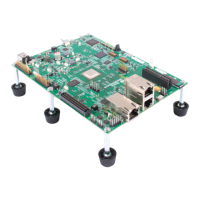TMS34010
C
Language
-
Declarations
•
K&R
states that structure and union member names must be
mutually
distinct. In TMS3401 0
C,
members
of
different
structures
or
un-
ions
can
have
the
same
name.
However, this requires that references
to the member
be
fully
qualified through all levels
of
nesting.
o
TMS34010
C
allows
assignment
to
and from structures, passing struc-
tures
as
parameters, and returning structures from functions.
•
K&R
contains a statement about the compiler determining the type
of
a
structure reference
by
the member name. Since TMS3401 0 C does
not
require member names
to
be unique, this statement does
not
apply. All
structure references must be
fully
qualified
as
members
of
the structure
or union in
which
they were declared.
Added
Type
-
Enumeration
Declarations
Enumerations
allow
the use
of
named integer constants in TMS3401 0
C.
The
syntax
of
an
enumeration declaration
is
similar
to
that
of
a structure or union.
The keyword
enum
is
substituted for struct or union, and a list
of
enumerators
is
substituted
for
the list
of
members.
Enumeration declarations have a
tag,
as
do
structure and
union
declarations.
This tag may be used in future declarations,
without
repeating the entire dec-
laration.
The
list
of
enumerators
is
simply a comma-separated list
of
identifiers.
Each
identifier can be
followed
by
an
equal sign and
an
integer constant.
If
there
is
no enumerator
followed
by
an
= sign and a value, then the first enumerator
is
assigned the value 0, the next
is
1, the next
is
2, etc. An identifier
with
an
assigned value assumes that value; the next enumerator
is
assigned that value
+ 1, the next
is
the preceding value + 1, etc. The assigned value may be ne-
gative,
but
the increments
are
still by positive 1.
The size
of
an
object
of
type
enum
is
determined
as
follows:
if
any
of
the
ob-
ject's enumerators have negative values, the object occupies
32
bits. Other-
wise, the object occupies the minimum number
of
bits required
to
represent
the largest enumerator
value and
is
considered
to
be
unsigned.
Unlike structure and union members, enumerators share their name space
with
ordinary variables and, therefore, must
not
conflict
with
variables or other en-
umerators in the same scope.
Enumerators can appear wherever integer constants
are
required; thus, they
can be used in arithmetic expressions, case expressions, etc.·
In addition, ex-
plicit
integer expressions may be assigned
to
variables
of
type enum. The
compiler does
no
range checking
to
insure the value
will
fit
in
the
enumeration
field. The compiler does, however, issue a warning message
if
an enumerator
of
one type
is
assigned to a variable
of
another.
Here's
an
example
of
an
enumerator declaration:
enum
color
red,
blue,
green
10,
orange,
purple
-2,
cyan
} :X;
4-9
